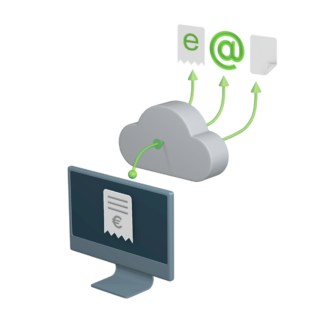
5 ways to benefit from e-invoices in accounts payable
Heikki Pulli
When it comes to adopting e-invoicing, the potential for cost savings is typically what’s driving organizations. The savings are also one of the most frequently asked questions: how much time and money could my organization save if we switched to e-invoicing in the accounts payable (AP)?
I answered the question recently in a webinar that focused on how to improve AP processes by implementing e-invoice receiving and digitalized purchase invoice processing. On a general level, an organization can save up to 64% per incoming invoice, when comparing the cost of receiving and handling a paper invoice to an automatically processed e-invoice (source: Business Case e-Invoicing. Report by Billentis. 2017).
The full benefits of e-invoicing can only be achieved through the broader digitalization of the Accounts Payable and Purchase-to-Pay processes. Exchanging electronic business documents with your trading partners enables transactional efficiency, which in turn unlocks automation, real-time visibility and control, and close buyer-supplier collaboration.
In this blog post, I’ll focus on e-invoicing in Accounts Payable and go over 5 key benefits of electronic invoice receiving and handling processes.
1. Receiving e-invoices: Reduce manual work and errors
In Europe, as much as 70% of all electronic invoices are still unstructured pdf or scanned paper invoices attached to emails. These don’t bring organizations the benefits that true e-invoicing would bring. A true e-invoice contains all the necessary data in a structured format and thus allows automatic processing of the invoice for both the supplier and the buyer.
The clear benefit of switching to e-invoice receiving is reduced manual work in the handling of incoming invoices. Instead of a manual key-in process, which is time-consuming and prone to errors, all the data is automatically entered into the Accounts Payable system. You can ensure that the data is 100% correct and meets the needs of your invoice workflow process. In addition, you can free your Accounts Payable staff’s time for more value-adding tasks.
2. Processing invoices: Automate matching and approval workflows
An efficient invoice handling process starts with excellence in purchasing practices. With electronic purchase orders, electronic goods received notes, and electronic invoices, the purchase invoice approval process can be reliably automated. In addition, VAT compliance can also be ensured automatically.
The three-way matching requires alignment between procurement and Accounts Payable: receiving supplier invoices as e-invoices is not enough. It is crucial to also focus on how the purchase orders are sent to the suppliers, what data they include, and how to make the data available for the approval process. Optimizing and digitalizing the communication with the suppliers along the entire Purchase-to-Pay chain helps organizations yield the biggest benefits.
3. Dispute management: Improve buyer-supplier communication
With electronic invoices, both the supplier and the buyer have better transparency and situational awareness of the invoicing process. Electronic invoice processes are typically prompt as the delays and inaccuracies related to handling paper are excluded from the process. This helps to avoid invoice disputes in the first place and, secondly, improves dispute handling.
With structured, validated invoice data and real-time information on the invoice status both in the Accounts Receivable on the supplier side and in the Accounts Payable on the buyer side, any inquiries about the invoices can be communicated and resolved more easily and quickly.
4. Payment: Optimize cash flows
Electronic exchange of invoices allows faster processing of purchase invoices. For the buyer organization, it means, for instance, an increased opportunity to take advantage of the possible early payment discounts offered by the supplier.
In addition, the visibility that comes from the automatic processing of invoice data into payment orders helps to improve cash flow control. When accurate and timely information on purchase invoices is available for monitoring and analysis at all times, it can be efficiently used to optimize working capital.
5. Archive: Enable easy access to information
In electronic archives, invoices can be quickly accessed if the information on them is needed for resolving inquiries or for further analysis and audit. Archiving in electronic format saves both physical space and time in Accounts Payable as slow manual searches can be replaced with easily searchable invoice data.
For more information about the cost savings and other benefits coming from switching to e-invoicing in accounts payable, please visit our Accounts payable page, or contact us.
Get an e-invoice system

For invoice receiving
All your e-invoices, PDF and paper invoices into one flow and one format, enabling AP automation.

For AP automation
Next-generation processing automation with artificial intelligence to replace out-dated practices.